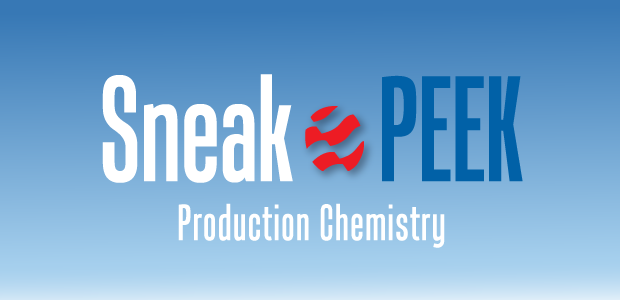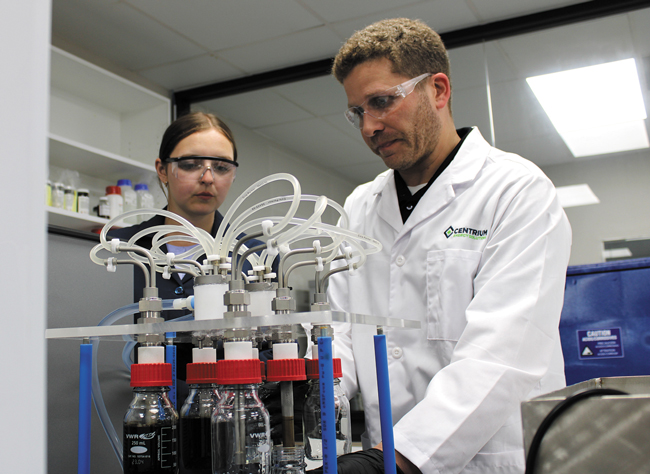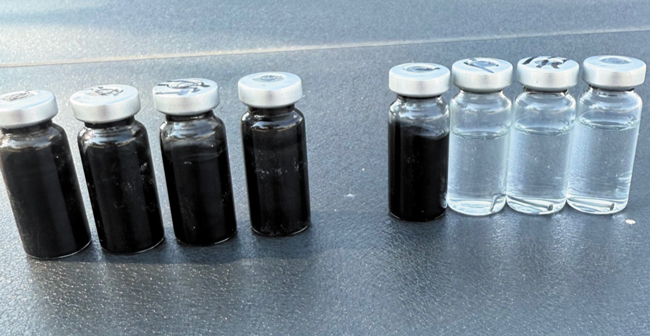
Next-Gen Chemistries Simultaneously Tackle Many Common Challenges
By Andrew Linnabary
The science of production chemistry is evolving, with operators across North America seeking more efficient, sustainable ways to maintain output from mature assets while lowering costs and water-handling burdens. From the laboratory benches of established chemical formulators to field pilots exploring cutting-edge nanobubble technology, companies are rethinking their approach to mitigating corrosion and scale and ensuring that produced water can go where it needs to go.
As with any chemical program, the ultimate goal is to fine-tune chemistries and dosage rates so that they solve current or potential problems at the lowest possible cost.
Today, more robust data and new technologies make finding the best chemistries easier than ever. But according to Justin Disney, director of laboratory and R&D services at Jacam Catalyst, the defining trend in production chemistry is the rise of multi-combination products—chemical formulations designed to handle three or four problems in a single treatment.
Combo Chemicals
“We’re seeing more triple or quadruple combo-type products that address scale, corrosion, paraffin, iron, or H2S together,” he reports. “Historically, the industry might have blended corrosion and scale inhibitors, but now we’re seeing needs for higher complexity in single chemical delivery.”
That shift reflects changing field realities, he says. The surge in production over the past few years has outpaced infrastructure growth in the Permian Basin and some other areas. The resulting constraints have encouraged pipelines and saltwater disposal wells to adopt stricter rules on the types of fluids they’ll accept or enforce existing rules with greater vigor.
“We’ve been a victim of our own success,” Disney says. “We’re producing so much oil, gas, and water that the infrastructure for takeaway hasn’t kept up. Operators might have a sweet-crude pipeline near the field but not a sour-oil line, or they may be limited on injection volumes for their water disposal. That puts pressure on them to treat their fluids to a higher standard before disposal or sale.”
Jacam Catalyst’s lab has developed several multi-dimensional chemistries in response, including a downhole product combining H2S removal with scale and corrosion inhibition that has proven to be extremely effective in the Permian Basin. “Limitations on sour service takeaways for oil, water, and gas along with short retention times at surface facilities make downhole treating a viable alternative. A range of product families were created to help optimize the scale, corrosion, and H2S scavenger ratios for each treatment application.”
“We tailor to the application,” Disney notes. “Maybe scale is the dominant issue, maybe it’s corrosion, or maybe they need additional H2S control. We work with the operator to find the right blend so they’re not overpaying for ingredients they don’t need.”
While these multipurpose blends can carry a higher unit cost than simpler, single-target chemicals, Disney says the economics balance out quickly.
“On a unit cost basis, the multi-combo products are probably more expensive,” he says. “But because it optimizes three or more problems with one product, one bulk tank, one chemical delivery mechanism, the overall treatment costs can be significantly lower.”
The approach is gaining traction, he says. Disney estimates that what was “a handful of operators” testing multi-combo treatments a few years ago has grown into “dozens” implementing or evaluating them today. The pace of innovation, he adds, has been unusually fast.
“Even though these problems have really surged only in the last couple of years, the response has been quick—rapid product development, testing, and implementation. Operators don’t have long timelines. They’re under financial or physical constraints, so we’ve had to move fast.”
Data, Collaboration, and Feedback
Behind every new formulation is extensive collaboration between laboratory scientists and field personnel. Jacam Catalyst relies on its account managers to collect detailed operational data to inform R&D decisions, Disney mentions.
“If all we do is focus on the lab side, we might miss something important,” he says. “That’s why there’s so much collaboration between the lab, product development experts, and field teams. They help us understand the unique challenges of each basin—whether that’s the water chemistry, temperature, or even something like needing a product rated for –40°F.”
Jacam Catalyst’s Sterling, Ks., facility houses the company’s laboratory and blending operations, where researchers develop and manufacture specialty production chemicals tailored for scale, corrosion, paraffin, H2S control, and other recurring issues. Jacam says the site also supports pilot testing and collaboration with field teams to customize formulations in order to meet specific basin needs and conditions.
Pilot testing plays a central role. Jacam Catalyst currently has multiple pilots underway in the Permian and Denver-Julesburg Basins, giving its scientists a real-time feedback loop to finetune formulations during commercial rollout. According to Disney, that iterative process also feeds growing data-integration efforts.
“More and more customers are data-intensive,” Disney says. “They’re using analytics platforms like Spotfire and Power BI to look at trends across multiple wells or over long time periods. That’s helping them and us understand which wells have which types of problems.”
Artificial intelligence, he adds, is on the horizon for production chemical R&D. “AI is already becoming more prominent on the analytics side,” he says. “We’re probably three to five years out from AI being a major part of laboratory development, but it’s coming. As operators rely more on data systems, the chemical side will need to integrate with those platforms.”
Environmental performance is another factor guiding design. Disney frames sustainability less in abstract carbon terms and more in operational efficiency.
“If we can increase well longevity and use less chemical overall, that’s lowering the industry’s carbon footprint,” he says. “Every well failure we prevent means less waste—less manpower, less equipment, and less replacement material.”
U.S.-Made Chemistry
At Centrium Energy Solutions, General Manager Jon Rogers sees corrosion control as the perennial cornerstone of production chemistry—and an area where domestic innovation still matters.
“If you look at the data, about 50% of the total spend on production chemicals in the Permian Basin is corrosion inhibitors,” Rogers says. “It’s the number one issue in both the Permian and the Bakken. The water produced with oil in both plays is much saltier than seawater and often very hot, so the systems are naturally corrosive. Without good inhibitors, a pipe that’s supposed to last 20 years could fail in less than one.”
In addition to providing chemistries from U.S. manufacturers, Centrium operates a laboratory in The Woodlands, Tx., where it replicates real-world brine and temperature conditions to help smaller service companies validate and optimize their formulations.
“We support smaller companies technically,” Rogers explains. “We can reproduce field conditions, compare products head-to-head, and run stability tests down to –40 degrees F. Performance and compatibility testing often show that while a higher-quality product may cost more per pound, it saves money by avoiding problems and sometimes letting companies use less.”
A persistent challenge, Rogers adds, is the influx of cheaper imported chemistries that can fail under U.S. field conditions.
Researchers at Centrium Energy Solutions conduct cold finger paraffin testing, a laboratory method used to evaluate wax deposition and chemical treatment performance in crude samples. The company says these controlled tests help tailor chemistries and correlate lab results with field performance, supporting its overall goal of integrating data, physics and treatment design to improve flow assurance in challenging wells.
“Over the last few years, people have tried to get cheaper versions from overseas,” Rogers says. “The quality is often poor. We’ve seen imidazoline-based inhibitors crystallize and separate in cold climates, plugging pumps or reacting with methanol antifreeze. Buyers might save 10% upfront, but the real cost is in downtime and failures.”
Rogers emphasizes that quality control and fit-for-purpose design often outweigh initial price considerations. He says demand for U.S.-made formulations reflects operators’ preference for reliability over short-term savings.
“It’s realizing that it’s not just whether it’s chemically a good corrosion inhibitor,” he says. “It’s whether that inhibitor can actually be pumped and applied properly in the environment where it needs to work. In the United States, quality matters.”
Wax and Scale
Corrosion may be the biggest expense in most production chemical programs, but Rogers says wax and scale continue to test the limits of current technology, with wax proving particularly vexing. He cites industry survey data showing that although wax control lags behind corrosion and scale in terms of spending, it’s a bigger source of frustration.
“About 31% of respondents said they were extremely unhappy with their wax-control programs,” Rogers details. “Wax can get worse over a well’s life because as the reservoir cools and lighter hydrocarbons move faster through the rock, the heavier waxes are left behind. That means the operator has to deal with more deposition and harder-to-treat flow issues over time.”
While existing products can help, especially once the blend has been optimized, Rogers says the next step forward may come from changes to chemicals’ molecular structure. To support such advances, Centrium’s lab and field teams work closely with chemical manufacturers such as Nouryon (formerly Akzo Nobel), providing data from the field that they rarely receive.
“One of the biggest complaints from the major chemical producers is that they don’t get enough field feedback,” Rogers says. “When we use one of their products in a formulation, we’ll go back to the field and tell them exactly how it performed. That helps everyone improve. You’ll see that collaboration on display at events like the Permian Basin International Oil Show, where our partners join us at the booth.”
Automation and AI are accelerating enhancements to treatment programs, Rogers reports. Real-time probes now monitor line pressures and detect scale or paraffin buildup, allowing operators to respond before failures occur.
“The future is faster optimization,” Rogers says. “If we ever get to real-time corrosion data, pumps could adjust automatically. We’ll never eliminate chemicals, but we can make sure the right product is doing the right job at the right rate.”
Nanobubbles
As chemistry experts refine their techniques for designing and applying treatments, Rapid Water Technologies is pushing the boundaries of how water itself can be engineered. The Michigan-based company has partnered with Bart French of JW Enterprises, who has a long history in the oil field, to introduce nanobubble generators that fundamentally change the physics of water.
French says the nanobubbles make it much easier to inject produced water for waterflood operations or disposal. “When we put the nanobubble generator on waterflood or disposal wells, the first thing operators see is cleaner water and lower pressure. Then the oil production goes up,” he says.
Rapid Water Technologies used serial dilution bottles to show the impact of its nanobubble-assisted treatment on sulfate-reducing bacteria in injection water, with the dark vials on the left representing untreated samples and the clear vials on the right showing bacteria reduction after 30 days of treatment using a static sidestream nanobubble generator. The company says the samples went from 1,000–9,999 colonies per milliliter down to just 1–9 colonies/mL—levels low enough that most oil producers could forego additional bacterial treatment.
In one ongoing field test, French reports that nanobubbles transformed calcium-carbonate scale into aragonite—a non-adherent form that doesn’t stick to pipe—eliminating the need for scale-inhibitor chemicals altogether.
“In that test, we’ve seen about 30% more oil production and stopped using scale inhibitors,” he says. “The nanobubbles reduce surface tension, improve water quality, and lower wellhead pressure.”
The generator requires no external gas or electricity, says Dave DeVree, who handles sales at Rapid Water. It creates roughly 35 million nanobubbles per milliliter using gases already entrained in the water as water passes through the device, which has a body manufactured from 316L stainless steel.
“It’s a static device—a one-time investment,” DeVree says. “You put it in and forget about it, because there is no maintenance and no moving parts. We make seven sizes for different flow rates and pressures, all manufactured in Michigan.”
Each nanobubble is only 1/2,500 the diameter of a grain of salt. Negatively charged and neutrally buoyant, the bubbles remain suspended, continually moving in what physicists call “Brownian motion,” French explains. He says this constant activity helps scrub oil from rock pores and prevent scale adhesion.
“The bubbles actually get between the rock and the oil and release trapped hydrocarbons,” French says. “Because of their charge, they repel each other, don’t agglomerate, and keep cleaning the system. As the injection well pushes bubbles through the formation, they pick up pieces of scale, debris, and other contaminants, keeping them from building up and causing issues.”
Early field applications in Kansas, Illinois, and Texas have shown major drops in injection pressure within weeks, followed by measurable increases in oil production within months. The team is now testing whether nanobubbles also reduce bacterial activity and H2S formation.
“A lot of H2S is caused by bacterial processes,” French notes. “If these bubbles kill bacteria, they could eliminate another chemical cost altogether.”
While bacteria testing has only just begun, French describes the initial results as extremely exciting. In a 30-day trial, the nanobubbles cut the amount of sulfate-reducing bacteria in injection water from 1,000-9,999 colonies a milliliter to 1-9 colonies/mL—a dramatic result, French says. That’s low enough that most producers would not need to add biocides, he explains, and similar methods could be employed to reduce SRBs in drilling and hydraulic fracturing operations.
Industry Adoption
For all its promise, nanobubble technology still faces the uphill task of education, French acknowledges. “People are hesitant with new technology,” he says. “They just need time to understand it.”
But once operators see the data—and the before-and-after water samples—the skepticism fades quickly, French and DeVree report.
“The treated water is crystal clear,” DeVree says. “A 12-ounce can of water might contain 12 billion nanobubbles, but you can’t see a single one. That’s hard for people to grasp, because they’re used to bubbles they can see in soda or beer. But once they see the injection pressure drop and oil go up, it clicks.”
The company describes its generators not as replacements for chemistry but as enhancements that improve water management. “Where chemicals are used, nanobubbles can make them work better or let you use less,” DeVree says. “In some systems, including some waterfloods, they eliminate chemicals altogether, but the broader goal is optimization.”
For other great articles about exploration, drilling, completions and production, subscribe to The American Oil & Gas Reporter and bookmark www.aogr.com.









